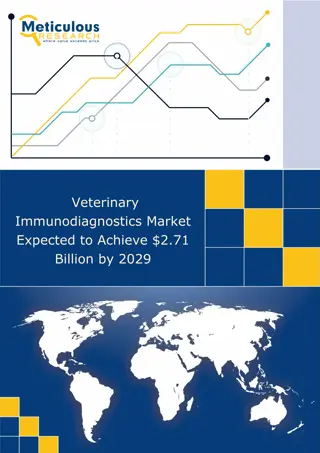
Radioimmunoassay in Immunoassay Techniques
Discover the sensitivity of radioimmunoassay (RIA) in detecting antigens and antibodies using radioisotopes. Explore RIA principles, procedures, applications, advantages, and limitations for accurate measurements in biological samples.
Download Presentation

Please find below an Image/Link to download the presentation.
The content on the website is provided AS IS for your information and personal use only. It may not be sold, licensed, or shared on other websites without obtaining consent from the author. If you encounter any issues during the download, it is possible that the publisher has removed the file from their server.
You are allowed to download the files provided on this website for personal or commercial use, subject to the condition that they are used lawfully. All files are the property of their respective owners.
The content on the website is provided AS IS for your information and personal use only. It may not be sold, licensed, or shared on other websites without obtaining consent from the author.
E N D
Presentation Transcript
StudyMafia.Org Radioimmunoassay Submitted To: Studymafia.org Studymafia.org Submitted By:
Table Contents Definition Introduction RIARequirements RIAPrinciples RIAProcedures RIAApplications RIAAdvantages RIALimitations Conclusion 2
Definition Radioimmunoassay is one of the sensitive immunoassay techniques which helps in the determination of antigens or antibodies in a sample with the use of radioisotopes. 3
Introduction When radioisotopes instead of enzymes are used as labels to be conjugated with antigens or antibodies, the technique of detection of the antigen-antibody complex is called radioimmunoassay (RIA). Radioimmunoassay (RIA) is an in vitro assay that measures the presence of an antigen with very high sensitivity. The classical RIA methods are based on the principle of competitive binding. In this method, an unlabeled antigen competes with a radiolabeled antigen for binding to an antibody with the appropriate specificity. 4
RIARequirements Radiolabeled antigens: The antigens are generally labeled with gamma-ray emitting isotopes such as I- 125 and beta-ray emitting isotopes such as Tritium. They are also called hot antigens. Specific Antibodies: They are required in smaller amounts than antigens. Unlabeled antigens (sample antigens): They are also called cold antigens. Microtitre plates: 96 wells microtitre plate Washing Buffer solutions: Wash buffer such as 1% Trifluoroacetic acid is used. 6
RIA Principles Antigens and antibodies bind specifically to form the Ag-Ab complex. The antigen can be labeled or conjugated with radioisotopes. The unlabeled antigens from the sample compete with radiolabeled antigens to bind on paratopes of specific antibodies. The unlabeled antigens replace labeled antigens that are already linked with the antibodies. The unlabeled antigens when bind with antibodies, increases the amount of free radiolabeled antigens in the solution. Hence the concentration of free labeled antigens is directly proportional to the bound unlabeled antigens. 7
RIA Principles It involves a combination of three principles: An antibody binding. A competitive binding or competitive displacement reaction. specificity) Measurement of radio emission. (It gives sensitivity) immune reaction i.e. antigen, (It gives 8
RIA Principle Immune Reaction When a foreign biological substance enters the body s bloodstream through a non-oral route, the body recognizes the specific chemistry on the surface of the foreign substance as antigen and produces specific antibodies against the antigen so as nullify the effects and keep the body safe. The antibodies are produced by the body s immune system so, it is an immune reaction. Here the antibodies or antigens bind and move due to chemical influence. 9
RIA Principles Competitive binding or competitive displacement reaction This is a phenomenon wherein when there are two antigens that can bind to the same antibody, the antigen with more concentration binds extensively with the limited antibody displacing others. So here in the experiment, a radiolabelled antigen is allowed to bind to a high-affinity antibody. Then when the patient serum is added to unlabeled antigens it starts binding to the antibody displacing the labeled antigen. 10
RIA Principles Measurement of radio emission Once the incubation is over, then washings are done to remove any unbound antigens. Then radio emission of the antigen-antibody complex is taken, and the gamma rays from the radiolabeled antigen are measured. The target antigen is labeled radioactively and bound to its specific antibodies (a limited and known amount of the specific antibody has to be added). 11
RIA Procedure antibodies concentration are fixed in the microtitre well. A known amount of hot antigens is then added to the well Washed carefully to remove any unbound antigens At this point, the radioactivity of the well will be maximum. Specific of known 12
RIA Procedure Unlabeled antigens are then added to the well The unlabeled antigens will bind to the antibodies and there will be free labeled antigens in the well. Again washed carefully to remove the free labeled antigens. Radioactivity of wells is then measured by gamma-counter. 13
RIA Applications It was first used for the detection of peptide hormones. Detection of different viral antigens Detection of many hormones and drugs Detection of Hepatitis B surface antigens Detection of mycotoxins Detection of the early stage of cancer 15
RIA Advantages High specificity High sensitivity Can detect a very small amount (nanograms) of antigen or antibodies. 16
RIA Limitations Working with radioactive substances makes it a bit risky. Disposal of radioactive substances can be problematic. Equipment and expensive. Radiolabeled substances used have a short shelf-life. reagents are 17
Conclusion Radioimmunoassay allows for the measurement of wide range of materials of clinical and biological importance. This technique has a significant impact on medical diagnosis due to the ease with which the tests can be carried out, while assuring precision, specificity and sensitivity. 18
References Google.com Wikipedia.org Studymafia.org Slidespanda.com
Thanks To StudyMafia.org






















